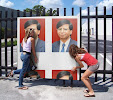Where is Dichaon Kalan anyway?
http://www.millenniumpost.in/NewsContent.aspx?NID=7263
28 August 2012, New Delhi, Sat Pal
The names of different localities in Delhi have interesting origins.
As regards Dichaon Kalan, one of my editor colleagues in Doordarshan News, while compiling a news bulletin asked me, where the village Dichaon Kalan was situated? Was it in Delhi, Haryana or Rajasthan? He was having an unconfirmed impression that it was somewhere in Delhi, hence, he called me to confirm as I am known as an expert on Delhi among my journalist friends. I confirmed that it was in Delhi and was close to Najafgarh. I dialed many friends of mine to check their level of knowledge. It came to me as a surprise that not even a single one had heard of the name. The village has historical background as the United States President Richard Nixon paid a visit to this less known village in 1969. The village was also declared a Model Village. The old timers relate this with its so called real name- Dev Uvach which means, from the mouth of Gods. The village has been in the news due to its musclemen. It looks like a prosperous village as the presence of the neo-riches is dominant. Further, the DDA and other agencies have been involved in taking up a number of projects around this village.
The names of the villages in Delhi can be classified in groups like sarai group – Neb Sarai, Katwaria Sarai, Sheikh Sarai, Phoos Sarai and others and the rauli group – Mehrauli, Gharauli, as well as the group dola – Bagdola, Budola and so on. As one look at the walled city, the names of lane and mohallas are associated either with personalities, events and stories. The name Gali Asharfai became popular because of an incident. Once a raees, rich man expressed his extreme happiness by throwing golden ginnies, asharfis, over the head of his son who was sitting on an elephant during his marriage procession. The persons who used to collect coins refused to take the asharafis due to an arrogance displayed by the raees. As people saw the entire lane covered with asharfis next morning, the lane was named as Gali Asharfi. Gali Parathewali and Kinari Bazar are famous because of the delicious parantahans and glittering decorative and ceremonial items respectively. The then new locality around the river means darya became famous as Darya Ganj. A katra in Chandni Chowk where the traders came from the area around river Neel in Egypt is still known as Katra Neel. The era after partition witnessed the influx of the refugees from the other part of the country. Those were the days when people used to take the patriots and freedom fighters in high esteem. Hence a number of refugee colonies were named after Sardar Patel, Subhash Bose, Nehru, Bal Gangadhar Tilak and so on. If we jump over to the 1970s when the number of rehabilitation colonies were developed by the DDA and the Union Government the names were grouped as Trilok Puri, Jahangir puri, Seema Puri, Sultan Puri, Mangol Puri, Jawala Puri, Raghubir Puri, Brahm puri; Nand Nagri, Sundar Nagri and so on.
During the development of housing colonies by allotting land to cooperative housing societies, the colonies were named after the offices and institutions whose employees were in majority in the societies formed.
The names of the colonies were known as Nirman Vihar, Swasthya Vihar, Yojana Vihar and Manak Vihar on the names of the ministries and offices like works and housing ministry, health ministry, the planning commission and and the Indian standards organisation respectively. A similar naming exercise continued in the multi-storey group housing societies. Some names of the colonies have no meanings. One may not find any sign of pleasantness in Welcome Colony. There are many colonies with similar name though they came up in different parts of the city. One may find Shastri Nagar in central and northeast Delhi and Ashok Nagar in west and east Delhi. There exists a renaming committee for the roads, parks and institutions. A similar committee, of course, is required for the colonies coming up.
Sat Pal is a communication consultant and has worked with several central and state ministers.

0 टिप्पणियाँ:
Post a Comment